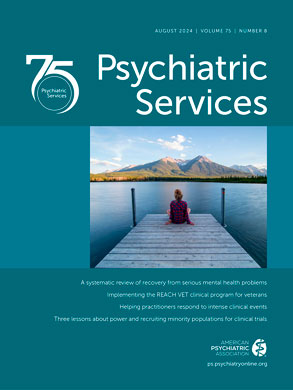To the Editor: Physicians who use depot antipsychotic medications to treat patients who are noncompliant struggle to achieve optimal benefits by increasing the dosage to minimize symptoms or reducing it to minimize side effects. Adjunctive use of novel antipsychotics with depot antipsychotics may offer another option. Three cases illustrate this approach.
In the first case, a 38-year-old man with a DSM-IV diagnosis of paranoid schizophrenia and a history of noncompliance with regimens of conventional and novel antipsychotics was hospitalized with florid psychosis. His score on the Brief Psychiatric Rating Scale (BPRS) was 109. (Possible scores range from 0 to 168, with higher scores indicating more severe symptoms.) Depot haloperidol was started at 50 mg a month, and the dosage was increased to 200 mg a month over two months, after which the patient was discharged. The medication improved the patient's symptoms and helped reduce his BPRS score to 38, but the dosage caused tremors in both arms that did not improve with benztropine. The next monthly dosage was lowered to 100 mg, but because of worsening psychosis (BPRS score of 101), adjunctive olanzapine was started and titrated to 20 mg a day. Depot haloperidol was continued at 100 mg a month. Over the next month, the patient's psychosis continued to improve (BPRS score of 44). He has complied with a regimen of oral olanzapine and depot haloperidol without further relapses or need for rehospitalization.
In the second case, a 58-year-old white man with a DSM-IV diagnosis of paranoid schizophrenia and a long history of poor compliance with several regimens of conventional and novel antipsychotics was started on depot haloperidol, and the dosage was increased to 250 mg a month. Over the next three months, he developed tardive dyskinesia in his hands and face, scoring 7 on the Abnormal Involuntary Movement Scale (AIMS). (Possible scores range from 0 to 40, with higher scores indicating more severe symptoms.) Anticholinergic agents did not help. Initially, compliance issues precluded the use of novel antipsychotics, but when the tardive dyskinesia worsened one month later (AIMS score of 8), depot haloperidol was tapered and stopped while risperidone was started and titrated to 8 mg a day. By the sixth month, the patient's psychosis and tardive dyskinesia improved (BPRS score of 36 and AIMS score of 6), and he became noncompliant and psychotic (BPRS score of 87). Depot haloperidol was restarted and increased to 125 mg a month. Initially, risperidone was continued at 8 mg a day, but because of increased sedation, the dosage was reduced to 6 mg a day. The patient has continued to adhere to this regimen, and his symptoms and tardive dyskinesia have remained stable.
In the third case, a 65-year-old man with a DSM-IV diagnosis of paranoid schizophrenia and a history of noncompliance with conventional and novel antipsychotics was admitted with psychosis and agitation (BPRS score of 107). After oral haloperidol was started at a dosage of 10 mg a day and depot haloperidol at 100 mg a month, the patient's symptoms improved (BPRS score of 53). However, a few days after discharge from his week-long hospitalization, he presented with acute dystonia while taking benztropine. After acute management, oral haloperidol was replaced with olanzapine at a dosage of 10 mg a day. Depot haloperidol was continued. The patient's symptoms had improved on follow-up one month later (BPRS score of 36), with no extrapyramidal symptoms. He has complied with this medication regimen and with regular follow-up.
About 50 percent of patients with schizophrenia become noncompliant with medication regimens, which leads to frequent rehospitalization (
1). Depot haloperidol or fluphenazine, which require administration of monthly dosages, minimize noncompliance but increase the risk of extrapyramidal symptoms and tardive dyskinesia (
2). Extrapyramidal symptoms improve with anticholinergic treatment and with dosage reduction or discontinuation of the antipsychotic medication, but tardive dyskinesia often persists after prolonged exposure to higher dosages (
3). Negative symptoms of schizophrenia may also be worsened (
4).
Novel antipsychotics reduce risks of extrapyramidal symptoms and tardive dyskinesia. They may also have antidepressant-like effects that improve negative symptoms (
5). However, novel antipsychotics require daily administration with the attendant risk of noncompliance. Until depot forms of these medications are available, adjunctive use of novel antipsychotics with depot antipsychotics may decrease noncompliance and minimize side effects. Long-term risks of this combination therapy are not known, and pharmacokinetic and pharmacodynamic interactions may occur, depending on the agents used. However, for some patients this approach is a viable option.

